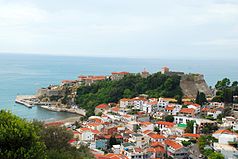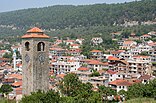
Back أولسيني Arabic اولسينى ARZ Ulsin Azerbaijani Улцынь Byelorussian Улцынь BE-X-OLD Улцин Bulgarian Ulcinj BS Ulcinj Catalan Ulcinj (kapital sa munisipyo) CEB Ulcinj Czech
Ulcinj
Улцињ Ulqin | |
|---|---|
Town and municipality | |
From the top, View over the city, Pasha Mosque, The Clocktower | |
| Coordinates: 41°55′N 19°12′E / 41.92°N 19.20°E | |
| Country | |
| Municipality | |
| Settlements | 39 |
| Government | |
| • Mayor | Omer Bajraktari (URA) |
| • Ruling coalition | URA–SD–SDP–AA–PD–Forca |
| Area | |
| • Town and municipality | 255 km2 (98 sq mi) |
| Population (2023 census) | |
| • Rank | 11th in Montenegro |
| • Density | 79.47/km2 (205.8/sq mi) |
| • Urban | 11,488 |
| • Rural | 9,907 |
| • Municipality | 21,395 |
| Demonym(s) | Ulcinjani Ulqinakë |
| Time zone | UTC+1 (CET) |
| • Summer (DST) | UTC+2 (CEST) |
| Postal code | 85360 |
| Area code | +382 30 |
| ISO 3166-2 code | ME-20 |
| Car plates | UL |
| Website | Official Website |
Ulcinj (Cyrillic: Улцињ, pronounced [ǔlt͡siɲ]; Albanian: Ulqin or Ulqini; Italian: Dulcigno) is a town in Coastal region of Montenegro and the capital of Ulcinj Municipality.[1] It has an urban population of 11,488.[2]
As one of the oldest settlements in the Adriatic coast, it was founded in 5th century BC. It was captured by the Romans in 163 BC from the Illyrians. With the division of the Roman Empire, it was a part of the Byzantine Empire and Serbian Kingdom in the Middle Ages until the Republic of Venice captured it in 1405.[3] It was known as a base for piracy.[4]
In 1571, Ulcinj was conquered by the Ottoman Empire with the aid of North African corsairs after the Battle of Lepanto.[5] The town gradually became a Muslim-majority settlement. Under the Ottomans, numerous oriental-style hammams, mosques, and clock towers were built. Ulcinj remained a den of piracy until this was finally put to an end by Mehmed Pasha Bushati. In 1673, the self-proclaimed Jewish Messiah Sabbatai Zevi was exiled here from Istanbul.[6]
Ulcinj remained an Ottoman town for more than 300 years until it was ceded to the Principality of Montenegro in 1878.[7] It is a former medieval Catholic bishopric and remains a Latin titular see.[8]
Ulcinj is a destination for tourists, because of its Long Beach, Lake Šas, Ada Bojana Island and for its two-millennia-old Ulcinj Castle.[9] There are 26 mosques in the town and surrounding countryside.[10] Ulcinj is the centre of the Albanian community in Montenegro.[11]
- ^ "Visit Ulcinj". Inspire your travels - latest. 18 February 2018. Retrieved 2021-06-18.
- ^ "Statistical Office of Montenegro". MONSTAT. Retrieved 2024-04-15.
- ^ "Ulcinj". Discover Montenegro. 2016-04-20. Retrieved 2021-06-18.
- ^ "The Ulcinj pirates – TO Ulcinj". TO Ulcinj – Welcome to TO Ulcinj. Retrieved 2021-06-18.
- ^ "Ulcinj in Middle Age – TO Ulcinj". TO Ulcinj – Welcome to TO Ulcinj. 2018-11-10. Retrieved 2023-05-09.
- ^ "Sabbatai Zevi – TO Ulcinj". TO Ulcinj – Welcome to TO Ulcinj. 2023-04-19. Retrieved 2023-05-09.
- ^ "The History of Ulcinj". Visit Montenegro. Retrieved 2021-06-18.
- ^ Čoralić, Lovorka (2011). "Verita d'alcuni heretici": The archbishop of Bar vs the count of Ulcinj - Two accusations, two testimonies (the sixteenth century)". Acta Histriae. 19 (3): 407–418.
- ^ "Ulcinj". My Guide Montenegro. Retrieved 2021-06-18.
- ^ "Ulcinj travel - Montenegro, Europe". Lonely Planet. 2019-09-08. Retrieved 2021-06-18.
- ^ "Montenegro - People". Encyclopedia Britannica. Retrieved 2021-06-18.
© MMXXIII Rich X Search. We shall prevail. All rights reserved. Rich X Search





